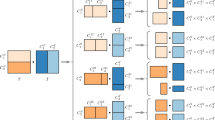Abstract
Let G=(V,E) be an undirected unweighted graph. A path between any two vertices u,v∈V is said to be t-approximate shortest path if its length is at most t times the length of the shortest path between u and v. We address the problem of building a compact data structure which can efficiently answer the following query for any u,v,x∈V and t>1:
Report t-approximate shortest path between u and v when vertex x fails.
We present data structures for the single source as well as all-pairs versions of this problem. The query time guaranteed by our data structures is optimal up to a constant factor. Moreover, the size of each of them nearly matches the size of the corresponding data structure with no failures.









Similar content being viewed by others
References
Aingworth, D., Chekuri, C., Indyk, P., Motwani, R.: Fast estimation of diameter and shortest paths (without matrix multiplication). SIAM J. Comput. 28(4), 1167–1181 (1999)
Baswana, S., Kavitha, T.: Faster algorithms for all-pairs approximate shortest paths in undirected graphs. SIAM J. Comput. 39(7), 2865–2896 (2010)
Baswana, S., Sen, S.: Approximate distance oracles for unweighted graphs in expected O(n 2) time. ACM Trans. Algorithms 2(4), 557–577 (2006)
Bernstein, A.: A nearly optimal algorithm for approximating replacement paths and k shortest simple paths in general graphs. In: Proceedings of the 21st Annual ACM-SIAM Symposium on Discrete Algorithms, pp. 742–755 (2010)
Bernstein, A., Karger, D.: A nearly optimal oracle for avoiding failed vertices and edges. In: Proceedings of the 41st Annual ACM Symposium on Theory of Computing, pp. 101–110 (2009)
Chechik, S., Langberg, M., Peleg, D., Roditty, L.: f-Sensitivity distance oracles and routing schemes. In: Proceedings of the 18th Annual European Symposium on Algorithms, pp. 84–96 (2010)
Cohen, E., Zwick, U.: All-pairs small-stretch paths. J. Algorithms 38(2), 335–353 (2001)
Demetrescu, C., Italiano, G.F.: A new approach to dynamic all pairs shortest paths. J. ACM 51(6), 968–992 (2004)
Demetrescu, C., Thorup, M., Chowdhury, R.A., Ramachandran, V.: Oracles for distances avoiding a failed node or link. SIAM J. Comput. 37(5), 1299–1318 (2008)
Dor, D., Halperin, S., Zwick, U.: All-pairs almost shortest paths. SIAM J. Comput. 29(5), 1740–1759 (2000)
Duan, R., Pettie, S.: Dual-failure distance and connectivity oracles. In: Proceedings of the 19th Annual ACM-SIAM Symposium on Discrete Algorithms, pp. 506–515 (2009)
Erdős, P.: Extremal problems in graph theory. In: Theory of Graphs and Its Applications, Proc. Sympos. Smolenice, 1963, pp. 29–36 Czech. Acad. Sci., Prague (1964)
Fredman, M., Tarjan, R.: Fibonacci heaps and their uses in improved network optimization problem. J. ACM 34, 596–615 (1987)
Harel, D., Tarjan, R.E.: Fast algorithms for finding nearest common ancestors. SIAM J. Comput. 13(2), 338–355 (1984)
Hershberger, J., Suri, S.: Vickrey prices and shortest paths: What is an edge worth. In: Proceedings of the 42nd IEEE Symposium on Foundations of Computer Science, pp. 252–259 (2001)
Hershberger, J., Suri, S., Bhosle, A.: On the difficulty of some shortest path problems. ACM Trans. Algorithms 3, 123–139 (2007)
Karger, D.R., Koller, D., Philips, S.J.: Finding the hidden path: time bounds for all-pairs shortest paths. SIAM J. Comput. 22, 1199–1217 (1993)
Lawler, E.: A procedure for computing the k best solutions to discrete optimization problems and its application to the k shortest paths problem. Manag. Sci. 18, 401–405 (1971/1972)
Malik, K., Mittal, A.K., Gupta, S.K.: The k most vital arcs in the shortest path problem. Oper. Res. Lett. 4, 223–227 (1989)
Nardelli, E., Proietti, G., Widmayer, P.: Finding the most vital node of a shortest path. Theor. Comput. Sci. 296(1), 167–177 (2003)
Roditty, L., Zwick, U.: Replacement paths and k simple shortest paths in unweighted directed graphs. In: Proceedings of the 32nd International Colloquium on Automata, Languages, and Programming, pp. 249–260 (2005)
Sleator, D.D., Tarjan, R.E.: A data structure for dynamic trees. J. Comput. Syst. Sci. 26, 362–391 (1983)
Thorup, M.: Fortifying OSPF/IS-IS against link-failure. Manuscript (2001)
Thorup, M., Zwick, U.: Approximate distance oracles. J. ACM 52(1), 1–24 (2005)
Yen, J.: Finding the k shortest loopless paths in a network. Manag. Sci. 17, 712–716 (1970/1971)
Acknowledgements
Part of the work was done while the authors were at Max-Planck Institute for Computer Science, Saarbruecken, Germany for the period May–July 2009. The authors are also grateful to anonymous referees for providing useful comments which led to improving the readability of the paper.
Author information
Authors and Affiliations
Corresponding author
Additional information
The results of the preliminary version of this article appeared in the proceedings of 27th International Symposium on Theoretical Aspects of Computer Science (STACS) held at Nancy, France during 6–8 March 2010.
This work was supported by Research I Foundation, CSE, IIT Kanpur and by Indo-German Max Planck Center for Computer Science (IMPECS).
Rights and permissions
About this article
Cite this article
Baswana, S., Khanna, N. Approximate Shortest Paths Avoiding a Failed Vertex: Near Optimal Data Structures for Undirected Unweighted Graphs. Algorithmica 66, 18–50 (2013). https://doi.org/10.1007/s00453-012-9621-y
Received:
Accepted:
Published:
Issue Date:
DOI: https://doi.org/10.1007/s00453-012-9621-y




